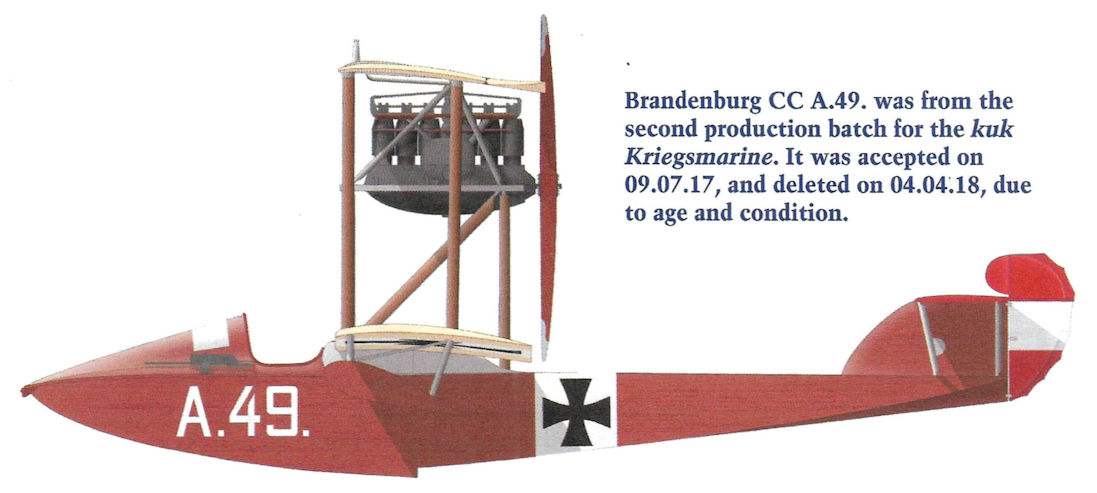O.Thetford, P.Gray German Aircraft of the First World War (Putnam)
Brandenburg W 17
First of the diminutive single-seat flying-boats. No details available, but doubtless data was not greatly dissimilar to that of W 18 which followed. Provision for two Spandau machine-guns.
W.Green, G.Swanborough The Complete Book of Fighters
BRANDENBURG W 17 (A 49) Germany
A single-seat fighter flying boat developed for the Austro-Hungarian Navy, the prototype of the W 17 (also designated A 49/1) was a biplane with a cantilever lower wing and was tested at Pola in July 1917. K.u.k. Linienschiffsleutnant Gottfried Banfield, responsible for the evaluation of the W 17, felt that the cantilever lower wing was unsuited for marine use and that the flying boat possessed inadequate manoeuvrability. Armament of the W 17 comprised two 8-mm Schwarzlose machine guns and the initial aircraft was allegedly lost when the upper wing broke away in flight. A second aircraft (the A 49/11) was completed as an equi-span triplane with interplane bracing struts. This is believed to have been submitted to the Austro-Hungarian Navy for evaluation in July 1917, but no details of these tests, or aircraft data, appear to have survived.
J.Herris German Seaplane Fighters of WWI (A Centennial Perspective on Great War Airplanes 2)
Brandenburg W17
The Brandenburg W17 flying boat fighter was a development of the Type CC; the key difference was the use of a different wing cellule. The W17 had a smaller lower wing and the star-struts were replaced by slanted, parallel struts. One aircraft was tested by the German Navy and the other, A.49, was flown operationally by Oblt. Gottfried Banfield, the leading Austro-Hungarian naval ace, in late summer 1917, but no further production was undertaken. Mounting two fixed machine guns, the W17 was a transitional design between the production CC and the production W18.
C.Owers Hansa-Brandenburg Aircraft of WWI Vol.2: Biplane Seaplanes (A Centennial Perspective on Great War Airplanes 18)
Type W.17
This machine is not recorded in the Typenschau but was a single-seat biplane flying boat fighter developed for the kuk Kriegsmarine. It was developed from the CC but had a cantilever lower wing. The upper wing was braced by struts from the engine mount, the 200-hp Hiero engine was fitted in the usual pusher configuration, together with an additional pair of struts braced the wing from the hull to the wing spars near the ailerons.(18) This machine was given the serial A.49. The first machine reportedly crashed when the upper wing broke away in flight. It is recorded as serving from July 1917 to April 1918.
Gottfried Banfield tested the A49 at Pola in July 1917 and did not recommend it as he was of the opinion that the cantilever lower wing was not suitable for maritime operations and it lacked manoeuvrability. The production machines were to have two 8-mm Schwarzlose machine guns as armament. The span is given as 9 m.(19) No other data are available.
Green and Swanborough state that a second machine was built as an equi-span triplane with interplane bracing struts, and received the serial A49/II (Apparently this would be why the first is referred to as A49/I). The existence of this second machine has not been confirmed.(20)
(18) A photograph of A.49. in full Austro-Hungarian markings appears in Die Flugzeuge derk.u.k. Luftfahrtruppe und Seeflieger 1914-1918, by Hauke, Schroder and Tbtschinger, P.177.
(19) Schupita, P. Op Cite P.77.
(20) Schupita does not record an A49/II.
E.Hauke, W.Schroeder, B.Totschinger Die Flugzeuge der k.u.k. Luftfahrtruppe und Seeflieger 1914-1918
Kampfflugboote
A.49. Type Brandenburg W. 17 FI 200
 |
C.Owers - Hansa-Brandenburg Aircraft of WWI. Volume 2 - Biplane Seaplanes /Centennial Perspective/ (18)
|
| Brandenburg CC A.49. was from the second production batch for the kuk Kriegsmarine. It was accepted on 09.07.17 and deleted on 04.04.18, due to age and condition.
|
 |
C.Owers - Hansa-Brandenburg Aircraft of WWI. Volume 2 - Biplane Seaplanes /Centennial Perspective/ (18)
|
| The Brandenburg W.17 fighter prototype was an intermediate step between the Brandenburg CC and W.18. Both those types were produced in quantity and saw operational service, while the W.17 remained a single prototype. Designed in Germany, the W.17 was evaluated by the Austro-Hungarian kuk Kriegsmarine and is shown here in the markings of that service.
|
 |
C.Owers - Hansa-Brandenburg Aircraft of WWI. Volume 2 - Biplane Seaplanes /Centennial Perspective/ (18)
|
| The W.17 under test by Brandenburg personnel before shipment to Austria-Hungary. Its development from the Type CC flying boat is evident in this view. Gottfried Banfield, the leading Austro-Hungarian naval ace, judged that the cantilevered lower wing was not sturdy enough for maritime operations.
|
 |
C.Owers - Hansa-Brandenburg Aircraft of WWI. Volume 2 - Biplane Seaplanes /Centennial Perspective/ (18)
|
The W.17 in Austro-Hungarian naval markings as A.49. The full story of this aircraft is unknown.
Only two W17 fighters were built and one, serial A.49, was supplied to the Austro-Hungarian navy, where it was flown operationally by Oblt. Gottfried Banfield, the leading Austro-Hungarian Naval ace.
|
 |
E.Hauke, W.Schroeder, B.Totschinger - Die Flugzeuge der k.u.k. Luftfahrtruppe und Seeflieger 1914-1918
|
| Abwehrflugzeug A.49, Type Brandenburg W.17, Puntisella, August 1917, Versuchsflugzeug
|
 |
C.Owers - Hansa-Brandenburg Aircraft of WWI. Volume 2 - Biplane Seaplanes /Centennial Perspective/ (18)
|
| The W.17 under test by Brandenburg personnel before shipment to Austria-Hungary. Its development from the Type CC flying boat is evident in this view. Gottfried Banfield, the leading Austro-Hungarian naval ace, judged that the cantilevered lower wing was not sturdy enough for maritime operations.
|







